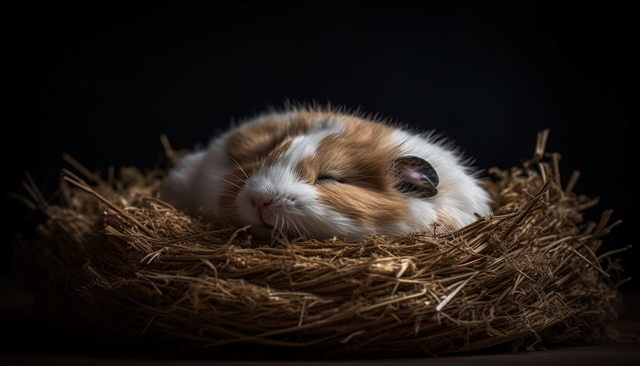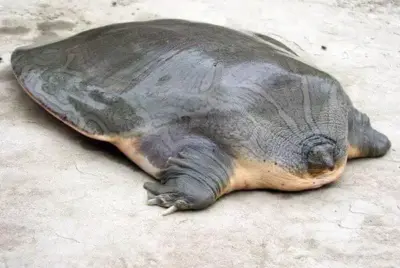Do Guinea Pigs Hibernate? A Deep Dive
Ah, guinea pigs! Those cute, fluffy balls of fur that squeak their way into our hearts. But as winter approaches, a common question pops up – do guinea pigs hibernate?
Let’s unravel this mystery together.
Understanding Guinea Pig Physiology
Guinea Pig Origins and Climate
Guinea pigs, originally from South America, have ancestors that roamed the Andean mountain edges. These regions, although having varied temperatures, do not experience extreme colds that would require animals to hibernate.
Physical Adaptations
These little creatures don’t have the fat reserves or physical adaptations that some animals have to endure prolonged periods of deep sleep during winter months.
The Myth of Guinea Pig Hibernation
When you think of animals hibernating, perhaps images of bears snugly sleeping in caves or hedgehogs curled up in nests come to mind. The concept of hibernation is well-known in the animal kingdom, with numerous creatures taking long rests to conserve energy during colder months. But when it comes to guinea pigs, there’s a prevalent myth that’s been circulating for years: Do these adorable rodents hibernate?
Let’s clear the air.
Origins of the Myth
The belief that guinea pigs hibernate likely arises from observations of their wild counterparts. In the wild, many animals hibernate to cope with harsh environments, especially when food becomes scarce. As guinea pigs originally hail from the Andean region of South America, where temperatures can vary, it might be easy to assume that they’ve adopted hibernation as a survival mechanism.
However, this assumption is misleading.
Guinea Pigs are Active Year-Round
Domesticated guinea pigs, the cuddly creatures we’ve come to adore, are descendants of wild guinea pigs. But through generations of domestication, they’ve adapted to human care and environments. Unlike some of their wild relatives, they don’t face the same survival challenges. In our homes, they have consistent access to food (along with human snacks such as apples and grapes), water, and warmth. As a result, they remain active all year round, with no biological need to hibernate.
Misinterpreting Their Behavior
Sometimes, a guinea pig might appear less active, especially during colder months or when unwell. This change in behavior might be misconstrued as them entering a hibernation-like state. In reality, a lethargic guinea pig is often a sign of illness or discomfort, not hibernation. It’s crucial for owners to recognize this difference and seek veterinary care when necessary.
What Actually Happens: Torpor
Guinea pigs don’t hibernate, but there’s another physiological state that can confuse guinea pig owners, known as torpor. While it might seem like hibernation at a glance, torpor is a distinct and shorter-term survival mechanism that some animals, though rarely guinea pigs, may exhibit. Let’s dive deeper into this phenomenon and its relevance to our furry friends.
Understanding Torpor
At its core, torpor is a short-term hibernation-like state. When animals enter torpor, they drastically reduce their metabolic rate, which in turn reduces their need for food and energy. Unlike hibernation, which can last for months, torpor usually lasts less than 24 hours. It’s like a “power-saving mode” for animals, helping them survive short periods of environmental stress or food scarcity.
How Torpor Differs from Hibernation
Hibernation and torpor might seem similar, but there are key differences:
1) Duration: As mentioned, hibernation can last for months, whereas torpor is short-lived, often lasting just a day or less.
2) Triggering Factors: Hibernation is usually seasonal, triggered by changing light levels and temperatures. Torpor, on the other hand, can be prompted by a sudden drop in temperature or food availability.
3) Metabolic Changes: While both states see a reduction in metabolic rate, the decrease is more drastic in hibernation. In torpor, animals can wake up more quickly if they sense danger or if conditions improve.
Do Guinea Pigs Enter Torpor?
It’s crucial to note that while some animals use torpor as a survival strategy, it’s exceedingly rare for guinea pigs. If a guinea pig appears lethargic or unresponsive, it’s more likely a sign of illness or distress rather than torpor. Any sudden behavioral changes in a guinea pig, especially those resembling a torpid state, should be addressed with immediate veterinary care.
Keeping Your Guinea Pig Warm and Safe
Ensuring that your guinea pig remains warm and comfortable, especially during colder months, is essential for their well-being. While guinea pigs might hail from temperate climates, they’ve become domesticated creatures accustomed to consistent environments. Let’s explore how to keep your guinea pig snug, safe, and happy no matter the weather.
The Importance of a Consistent Environment
Guinea pigs thrive in stable environments where there aren’t drastic fluctuations in temperature. Sudden changes can stress them out and potentially lead to health issues. A consistent environment helps maintain their body temperature, ensuring their bodily functions work optimally. This also helps to keep costs down for yourself.
Ideal Temperature for Guinea Pigs
The optimal temperature range for guinea pigs is between 65°F and 75°F (18°C to 24°C). Anything below or above this range can be uncomfortable or even harmful. Excessive cold can lead to respiratory issues, while excessive heat can cause heatstroke.
Tips for Winter Care
1) Draft-Free Zone: Ensure the cage or enclosure is placed away from drafts, windows, or doors that open frequently. This prevents cold air from chilling your guinea pig.
2) Bedding: Provide extra bedding during colder months. Hay, fleece, or soft bedding can help retain warmth. Ensure it’s changed regularly to maintain hygiene.
3) Warm Huts or Hideouts: Guinea pigs love to burrow. Providing them with cozy hideouts or igloos can give them a warm place to snuggle.
4) Use of Gentle Heating: Heating pads designed for pets, placed under half of the cage, can provide a warm spot. Ensure it’s not too hot and always provide an area where the guinea pig can move away from the heat if needed.
Monitoring Their Health
Cold environments can sometimes lead to respiratory issues in guinea pigs. Always keep an eye out for symptoms like wheezing, frequent sneezing, or a runny nose. If you notice any signs of distress or illness, consult with a veterinarian promptly.
Avoiding Overheating
While our focus is on keeping guinea pigs warm, remember that they can also suffer from overheating. In warmer months, ensure they’re kept in a shaded area, provide plenty of water, and consider using a small fan or frozen water bottles (wrapped in cloth) to cool their environment.
What to Do If Your Guinea Pig Enters Torpor
Discovering your guinea pig in a state of torpor can be a frightening experience. They may appear lifeless, with slower breathing and a colder body temperature. It’s crucial to act promptly, but calmly, to revive them and ensure their well-being. Here’s a guide on what steps to take if you find your guinea pig in this state.
Stay Calm and Assess the Situation
It’s essential to remain calm. Panicking can delay the necessary steps you need to take to assist your guinea pig. Gently touch your guinea pig and observe any signs of breathing or movement.
Gradually Warm Them Up
1) Warmth by Touch: Start by gently picking up your guinea pig and holding them close to your body. Your body warmth can help increase their temperature.
2) Use Warm Towels: Drape a warm towel or cloth over them. You can warm a towel by placing it on a radiator or using a hairdryer on a low setting. Ensure the towel isn’t too hot.
3) Avoid Direct Heat: Refrain from using direct heating sources, like heating pads, without a buffer, as this could cause burns or overheat them rapidly.
Offer Warm Fluids
Once your guinea pig shows signs of movement and seems to be waking up from the torpor state, you can offer them some lukewarm water with a syringe (without a needle). Hydration can help their system restart and speed up recovery.
Keep Them Comfortable
Place them back in their cage or enclosure, ensuring it’s warm and free from drafts. Add extra bedding, and ensure they have easy access to food and water.
Monitor Closely
For the next few hours, keep a close eye on your guinea pig. Watch for any signs of distress or unusual behavior. They might be disoriented or weak after coming out of torpor.
Consult a Veterinarian
Even if your guinea pig seems to recover fully, it’s a good idea to consult with a veterinarian. They can provide a thorough check-up and give advice on preventing future episodes.
Prevention is Key
To avoid future torpor episodes, ensure your guinea pig’s environment remains within the ideal temperature range. Regularly check their living conditions, provide appropriate bedding, and keep them away from drafty areas.
Conclusion
In conclusion, while guinea pigs don’t hibernate, they can enter a state called torpor under certain conditions. It’s crucial to know the difference and how to keep our furry friends safe and warm. Always remember: a warm guinea pig is a happy guinea pig!
Our furry companions rely on us to understand their needs and protect them from potential dangers. As enthusiasts and caregivers, it’s our responsibility to ensure they have a safe and comfortable environment, especially during colder months. By staying informed and proactive, we can ensure our guinea pigs remain active, healthy, and squeaky throughout all seasons. This in turn will ensure your guinea pig lives a longer life.
It’s a remarkable journey, understanding the intricacies of these small creatures. And while they might not curl up and hibernate like some animals, they have their own unique ways to cope with challenges. The bond between a guinea pig and its caregiver strengthens with such knowledge, leading to many happy, chirping moments together.
So, the next time someone wonders if guinea pigs hibernate, you’ve got the answer and a wealth of information to back it up! Remember, these little ones are resilient, but they also count on our love and care to thrive. Happy caring!
FAQ About Guinea Pigs and Hibernation
Do all guinea pigs hibernate?
No, guinea pigs do not hibernate.
How can I tell if my guinea pig is in torpor or just sleeping?
Torpor will involve a very lethargic state, cold body, and slowed breathing.
Can torpor harm my guinea pig?
Yes, extended periods in torpor without intervention can be fatal.
How long can a guinea pig be in torpor?
It varies, but immediate action should be taken.
Are certain breeds more susceptible to torpor?
No, all guinea pig breeds can potentially enter torpor under the right conditions.




